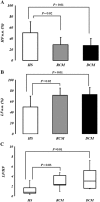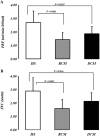Cardiac and peripheral autonomic control in restrictive cardiomyopathy
- PMID: 28772037
- PMCID: PMC5542737
- DOI: 10.1002/ehf2.12142
Cardiac and peripheral autonomic control in restrictive cardiomyopathy
Abstract
Aims: Autonomic dysfunction determines the advance of dilated cardiomyopathy (DCM) and is related to poor outcomes. However, this autonomic imbalance is unknown in patients with restrictive cardiomyopathy (RCM) even though they have similar symptoms and poor quality of life as DCM patients have. The aim of this study was to evaluate if autonomic and neurovascular controls were altered in RCM patients.
Methods and results: Fifteen RCM patients, 10 DCM patients, and 10 healthy subjects were evaluated. Heart rate and blood pressure (BP) were recorded. Peripheral sympathetic activity [muscle sympathetic nerve activity (MSNA)] by microneurography and cardiac sympathetic activity by power spectrum analysis of heart rate variability. Spontaneous baroreflex sensitivity (BRS) was evaluated by the sequence method and forearm blood flow by venous occlusion plethysmography. Both cardiomyopathy groups had higher MSNA frequency (P < 0.001) and MSNA incidence (P < 0.001), higher cardiac sympathovagal balance (P < 0.02), reduced BRS for increase (P = 0.002) and for decrease in BP (P = 0.002), and lower forearm blood flow (P < 0.001) compared with healthy subjects. We found an inverse correlation between BRS for increase and decrease in BP and peripheral sympathetic activity (r = -0.609, P = 0.001 and r = -0.648, P < 0.001, respectively) and between BRS for increase and decrease in BP and cardiac sympathetic activity (r = -0.503, P = 0.03 and r = -0.487, P = 0.04, respectively).
Conclusions: The RCM patients had cardiac and peripheral autonomic dysfunctions associated with peripheral vasoconstriction. Nonetheless, the presence of normal ejection fraction underestimates the evolution of the disease and makes clinical treatment difficult. These alterations could lead to a similar cardiovascular risk as that observed in DCM patients.
Keywords: Baroreflex control; Dilated cardiomyopathy; Heart failure; Neurovascular control; Restrictive cardiomyopathy; Sympathetic activity.
© 2017 The Authors. ESC Heart Failure published by John Wiley & Sons Ltd on behalf of the European Society of Cardiology.
Figures




Similar articles
-
Effect of exercise training on cardiovascular autonomic and muscular function in subclinical Chagas cardiomyopathy: a randomized controlled trial.Clin Auton Res. 2021 Apr;31(2):239-251. doi: 10.1007/s10286-020-00721-1. Epub 2020 Sep 1. Clin Auton Res. 2021. PMID: 32875456 Clinical Trial.
-
Dissociation between reflex sympathetic and forearm vascular responses to lower body negative pressure in heart failure patients with coronary artery disease.Am J Physiol Heart Circ Physiol. 2009 Nov;297(5):H1760-6. doi: 10.1152/ajpheart.00012.2009. Epub 2009 Sep 4. Am J Physiol Heart Circ Physiol. 2009. PMID: 19734366
-
Evening but not morning aerobic training improves sympathetic activity and baroreflex sensitivity in elderly patients with treated hypertension.J Physiol. 2024 Mar;602(6):1049-1063. doi: 10.1113/JP285966. Epub 2024 Feb 20. J Physiol. 2024. PMID: 38377223 Clinical Trial.
-
Relationship between spontaneous sympathetic baroreflex sensitivity and cardiac baroreflex sensitivity in healthy young individuals.Physiol Rep. 2015 Nov;3(11):e12536. doi: 10.14814/phy2.12536. Physiol Rep. 2015. PMID: 26564059 Free PMC article.
-
Autonomic neural functions in space.Curr Pharm Biotechnol. 2005 Aug;6(4):319-24. doi: 10.2174/1389201054553743. Curr Pharm Biotechnol. 2005. PMID: 16101470 Review.
Cited by
-
Investigating the Interplay between Cardiovascular and Neurodegenerative Disease.Biology (Basel). 2024 Sep 26;13(10):764. doi: 10.3390/biology13100764. Biology (Basel). 2024. PMID: 39452073 Free PMC article. Review.
-
α7nAChR on B cells directs T cell differentiation to prevent viral myocarditis.JCI Insight. 2025 May 8;10(9):e189323. doi: 10.1172/jci.insight.189323. eCollection 2025 May 8. JCI Insight. 2025. PMID: 40337863 Free PMC article.
-
Cardiomyopathies: An Overview.Int J Mol Sci. 2021 Jul 19;22(14):7722. doi: 10.3390/ijms22147722. Int J Mol Sci. 2021. PMID: 34299342 Free PMC article. Review.
-
Early Left Ventricular Diastolic Dysfunction, Reduced Baroreflex Sensitivity, and Cardiac Autonomic Imbalance in Anabolic-Androgenic Steroid Users.Int J Environ Res Public Health. 2021 Jun 29;18(13):6974. doi: 10.3390/ijerph18136974. Int J Environ Res Public Health. 2021. PMID: 34209901 Free PMC article.
-
Risk stratification in cardiomyopathy.Eur J Prev Cardiol. 2020 Dec;27(2_suppl):52-58. doi: 10.1177/2047487320961898. Eur J Prev Cardiol. 2020. PMID: 33238741 Free PMC article. Review.
References
-
- Abelmann WH, Lorell BH. The challenge of cardiomyopathy. J Am Coll Cardiol 1989; 13: 1219–1239. - PubMed
-
- Sorajja P. Invasive hemodynamics of constrictive pericarditis, restrictive cardiomyopathy, and cardiac tamponade. Cardiol Clin 2011; 29: 191–199. - PubMed
-
- Sanchez Torres RJ, Calderon R. The cardiomyopathies, a review for the primary physician. P R Health Sci J 2004; 23: 285–292. - PubMed
-
- Salemi VM, Leite JJ, Picard MH, Oliveira LM, Reis SF, Pena JL, Mady C. Echocardiographic predictors of functional capacity in endomyocardial fibrosis patients. Eur J Echocardiogr 2009; 10: 400–405. - PubMed
LinkOut - more resources
Full Text Sources
Other Literature Sources

